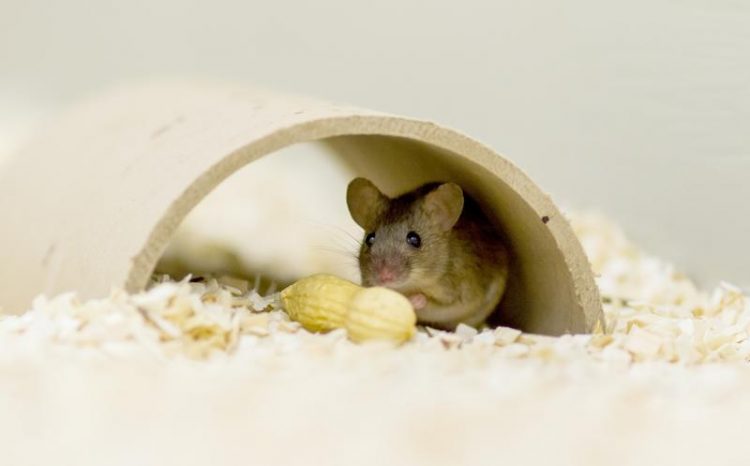Poop instead of needle prick: New, simpler method to measure hormones

Mouse Bettina Wernisch/Vetmeduni Vienna
Testosterone is the main reproductive hormone in male vertebrates. Conventional methods to assess testosterone rely on invasive blood sampling procedures, which can induce pain and distress to the animals.
Analysing hormone metabolites – the metabolized products of a specific hormone – in excreta would be a fast and simple alternative. However, metabolism and excretion of hormones vary considerably between species and sometimes even between sexes, which has previously limited the applicability of this method.
Breakthrough in hormone sampling from excreta
A team from Vetmeduni Vienna headed by Kerstin E. Auer of the Institute of Laboratory Animal Science and Rupert Palme of the Unit of Physiology, Pathophysiology and Experimental Endocrinology, in collaboration with the Institute of Animal Welfare, Animal Behavior and Laboratory Animal Science at the Freie Universität Berlin, has now taken the decisive step to validly assess hormone levels in excreta of mice.
In a multi-phase validation experiment, the researchers identified and validated a testosterone enzyme immunoassay (EIA) – also known as enzyme-linked immunosorbent assay (ELISA), a commonly used biochemistry investigative procedure – as suitable for measuring testosterone metabolites in male and female mice.
Wide applicability of the new test method
According to Kerstin E. Auer, the new procedure can be used in numerous areas: “Our non-invasive method to assess faecal TMs can be widely used to investigate hormone-behaviour relationships and can be applied in various other research areas such as reproduction, animal welfare, ecology, conservation and biomedicine.”
The animals themselves benefit from the development of the new test procedure, as invasive blood sampling is no longer necessary for the determination of hormone metabolites. With the data that were obtained, the scientists were also able to extend their knowledge of the endocrine physiology of mice.
Non-invasive method as alternative to conventional procedure
The aim of the study was to establish a non-invasive alternative to conventional blood sampling procedures for hormone assessment. The research team assessed testosterone metabolites (TMs) in faecal and urinary samples in mice and validated the applied EIA to measure TMs. The researchers also assessed diurnal fluctuations in TM excretions in male and female mice and across mouse strains.
“We found that males excreted significantly more radio-labelled TMs via the faeces compared to females and that TM excretion patterns differed significantly between urinary and faecal samples. TM excretion also depended on the animal’s activity patterns. Animals excreted TM faster during the night, when they were more active, than during the day, when they were in their resting period. We found no strain-specific differences between the animals. However, males did show diurnal fluctuations in their testosterone levels in comparison to females. As expected, males also showed higher faecal TM levels than females,” says Kerstin E. Auer.
Service:
The article “Measurement of Fecal Testosterone Metabolites in Mice: Replacement of Invasive Techniques” by Kerstin E. Auer, Marius Kußmaul, Erich Möstl, Katharina Hohlbaum, Thomas Rülicke and Rupert Palme was published in Animals.
https://www.mdpi.com/2076-2615/10/1/165
About the University of Veterinary Medicine, Vienna:
The University of Veterinary Medicine, Vienna in Austria is one of the leading academic and research institutions in the field of Veterinary Sciences in Europe. About 1,300 employees and 2,300 students work on the campus in the north of Vienna which also houses five university clinics and various research sites. Outside of Vienna the university operates Teaching and Research Farms. The Vetmeduni Vienna plays in the global top league: in 2019, it occupies the excellent place 5 in the world-wide Shanghai University veterinary in the subject “Veterinary Science”. http://www.vetmeduni.ac.at
Kerstin E. Auer
Institute of Laboratory Animal Science and Biomodels Austria
Department for Biomedical Sciences
University of Veterinary Medicine Vienna (Vetmeduni Vienna)
T +43 1 25077-2813
Kerstin.Auer@vetmeduni.ac.at
The article “Measurement of Fecal Testosterone Metabolites in Mice: Replacement of Invasive Techniques” by Kerstin E. Auer, Marius Kußmaul, Erich Möstl, Katharina Hohlbaum, Thomas Rülicke and Rupert Palme was published in Animals.
https://www.mdpi.com/2076-2615/10/1/165
https://www.vetmeduni.ac.at/en/infoservice/press-releases/press-releases-2020/po…
Media Contact
All latest news from the category: Life Sciences and Chemistry
Articles and reports from the Life Sciences and chemistry area deal with applied and basic research into modern biology, chemistry and human medicine.
Valuable information can be found on a range of life sciences fields including bacteriology, biochemistry, bionics, bioinformatics, biophysics, biotechnology, genetics, geobotany, human biology, marine biology, microbiology, molecular biology, cellular biology, zoology, bioinorganic chemistry, microchemistry and environmental chemistry.
Newest articles

Biophysics: Testing how well biomarkers work
LMU researchers have developed a method to determine how reliably target proteins can be labeled using super-resolution fluorescence microscopy. Modern microscopy techniques make it possible to examine the inner workings…

Making diamonds at ambient pressure
Scientists develop novel liquid metal alloy system to synthesize diamond under moderate conditions. Did you know that 99% of synthetic diamonds are currently produced using high-pressure and high-temperature (HPHT) methods?[2]…

Eruption of mega-magnetic star lights up nearby galaxy
Thanks to ESA satellites, an international team including UNIGE researchers has detected a giant eruption coming from a magnetar, an extremely magnetic neutron star. While ESA’s satellite INTEGRAL was observing…





















